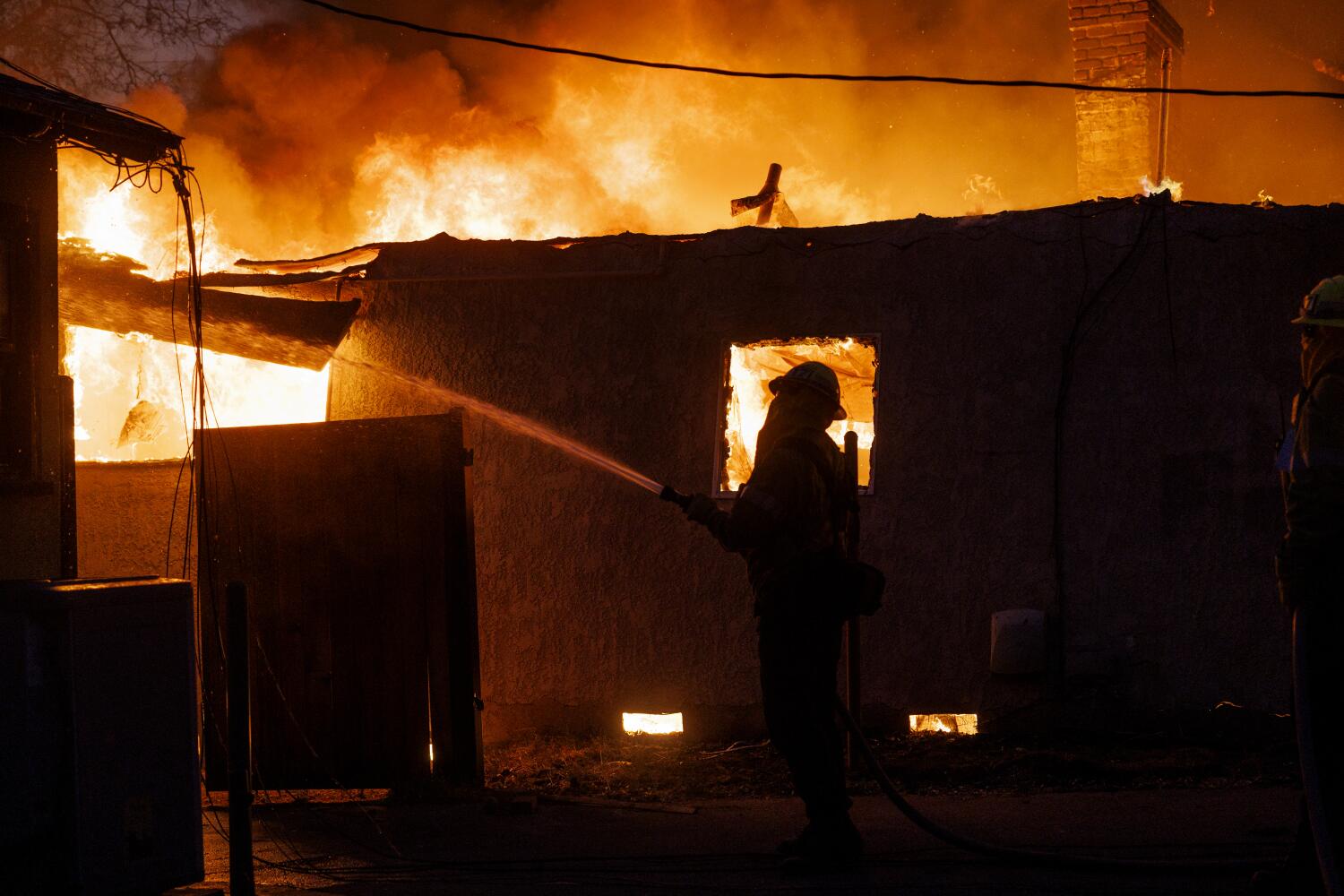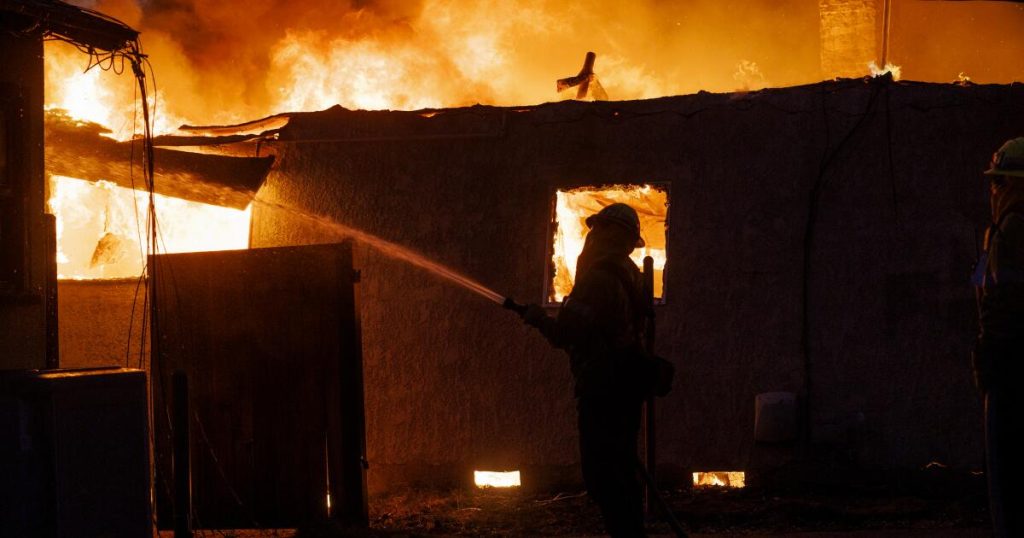
When Michael Olson saw what would become the Eaton Fire, the flames at the base of the power tower were small and seemingly manageable.
Then, on the night of January 7, the wind blew and sent a shower of sparks down the mountainside above his Pasadena home.
“Within 10 minutes, the whole landscape lit up,” Olson, 70, told the Times. “It was just a pile of flames.”
The only thing separating his backyard from the fire was a dry riverbed. As Olson and his wife drove away, a fire truck pulled into the neighborhood.
“I left the house thinking I would never see it again,” he said.
Instead, Olson and her neighbors returned to find that the fire that had destroyed large areas south and west of Altadena and killed at least 16 people had not damaged their homes. Some people returned to find trees in their backyards scorched and decks damaged. This was a sign that the fire was becoming dangerous. The gutters of one house were left sagging, as if they had begun to melt.
However, dozens of nearby properties that authorities believe were the flashpoints were found intact. Some residents have already returned to their neighborhoods, albeit surrounded by ash and rubble. The evacuation zone is guarded by armed troops and police, and no people are allowed in or out, leaving people struggling to get food and other essentials.
Survivors are now trying to understand how their homes, located at the epicenter of such a devastating fire, survived when so many others were destroyed.
“Is this an act of God?” Olson asked. “Good karma? I told people that I used up a lot of good karma that day.”
Winds caused inferno, but some houses were spared
Residents on Canyon Close Road, nestled between mountains, have uninterrupted line of sight from their backyards to power towers, and Olson and others said they saw the blaze on Jan. 7 at about 6:15 p.m. He said he witnessed it go up.
There are several theories to explain why the Eaton Fire burned the horseshoes of Olson Street and the surrounding area, but not a single house went up in flames.
“It could be wind, it could be brush cutting, it could be luck,” said Scott Brown, a firefighter assigned to Los Angeles County Fire Station 66, about a mile east of Kinneloa Valley. His best guess: “All three.”
To understand how the fire spread and the decisions that led to the rescue of some homes, The Times spoke to fire officials, first responders, residents and experts to find out how the Eaton Fire started. Hours of radio communications by emergency personnel from the night were examined.
Firefighters were stationed on streets east, west and south of the fire scene. They sprayed water on the burning hillside, but 110 mph winds blew the embers overhead, sparking new fires as far as two miles to the rear.
“This is something I’ve never experienced in my 20 years,” said Pasadena Fire Department Battalion Chief Danny Nausha, the fire’s initial incident commander. “We placed devices closest to the edge of the fire to prevent it from entering the building, but many of the embers ended up scattering into the neighborhood.”
Olson and her neighbors believe their home survived for two reasons. As an example, fire departments in Pasadena and Los Angeles counties flooded the streets where crews first responded to the Eaton Fire before fires broke out in other areas and forced them to divide resources. I was able to do it.
Like Nausha, Olson also credits the wind. The same gusts of wind that brought the fire to its head, raining burning wood debris like cluster bombs onto West and South streets may have saved their home, Olson said.
“It hit us,” he said.
At 6:26 p.m. on Jan. 7, about 15 minutes after the Eaton Fire was first reported, firefighters near Canyon Close Drive said the fire had grown to 10 acres and was experiencing “high pressure,” according to radio communications. It was reported that the area under the power lines was on fire. A minute later, workers on nearby Canyon View Lane radioed to report embers pouring toward homes.
At 6:33 p.m., firefighters on Canyon Close Drive reported “huge embers falling” and called for help, eventually requesting five more engines, according to communications. Pasadena Fire Chief Chad Augustin said embers were already igniting trees and structures more than a mile away.
Other departments in the area were already stretched thin that night and could not get immediate backup.
Brendan Thorne, 28, who was protecting his home on Canyon Close Road with a garden hose, saw embers arcing overhead and what he saw was “just a huge fireball.”
Most sailed over the house his great-grandparents built 70 years ago.
“We are very, very grateful,” Thorne said. “But I feel so guilty, especially my mother. It sounds strange to say that.”
One ember landed in the backyard of Laurie Bilotta, who lives next door to Thorne. It was so hot that a metal ladder in the backyard melted. Some bushes also caught fire, but Bilotta’s home of 39 years survived.
Bilotta, 72, pointed Wednesday to the trees in his backyard.
“I didn’t touch a hair on their head, I didn’t touch a leaf on a branch,” she said. “That’s a miracle.”
Firefighter’s oath: “I will protect my castle”
Brown defended his family’s home in Kinelloa Valley, about a mile east of Bilotta’s home.
Brown, 44, was off duty the night of Jan. 7 and had just eaten dinner at Villa Katrina’s in Arcadia when he received the alert about Eaton Canyon.
Brown returned to his station, grabbed his equipment and headed home. He loaded his personal belongings into his car and used the skills he learned as a firefighter to protect his family’s home.
“I’ve been planning this day for 31 years,” Brown said. Brown was in eighth grade when the 1993 Kineola Fire threatened his home. “I will protect my castle.”
Brown dragged flammable furniture out of the house, doused the roof and walls with water and turned on the sprinklers, then did the same to a neighbor’s house.
With the help of fire trucks, Mr Brown managed to extinguish the blaze in the neighborhood until 1.30am, when the wind died down for several hours, allowing firefighters to get a grip on the blaze in the Kinneroa Valley.
Brown said she made grilled cheese sandwiches before spending the next seven hours going door to door to check for water main breaks that would dry up the fire department’s supply.
Nausha of the Pasadena Fire Department bounced from house fire to house fire, trying to respond to each new blaze caused by swirling embers.
“As the fire progresses, we put it out in one area and quickly move on to the next area,” he said. “They constantly moved from fire to fire.”
Living in an evacuation zone: ‘It’s like the Berlin Wall’
By Wednesday, some residents had returned to Canyon Close Road, which was still under an evacuation order. Some did not plan to leave the area, fearing they would not be allowed back in as long as the National Guard, Los Angeles County Sheriff’s Deputies and California Highway Patrol continued to guard the area.
Residents said they felt like they were under siege. Their home had electricity and limited cell phone service, but no gas. Some people were surviving on emergency rations such as powdered peanut butter and applesauce, said B.J. Thorne, whose son was protecting the house with a garden hose.
BJ Thorne, a former elementary school teacher, said her sister was turned away at a National Guard checkpoint from Ralph’s with a large shipment of groceries. BJ Thorne called his sister and asked if she could give him some food. The military said no.
“It’s a bit like the Berlin Wall,” she said.
BJ Thorne and his son are indoors most of the day. She said she was worried that if they were caught outside after the 6 p.m. curfew, the National Guard would “escort” them from the evacuation zone.
“The Sheriff’s Office is also very diligent about finding looters,” she said.
Source link




